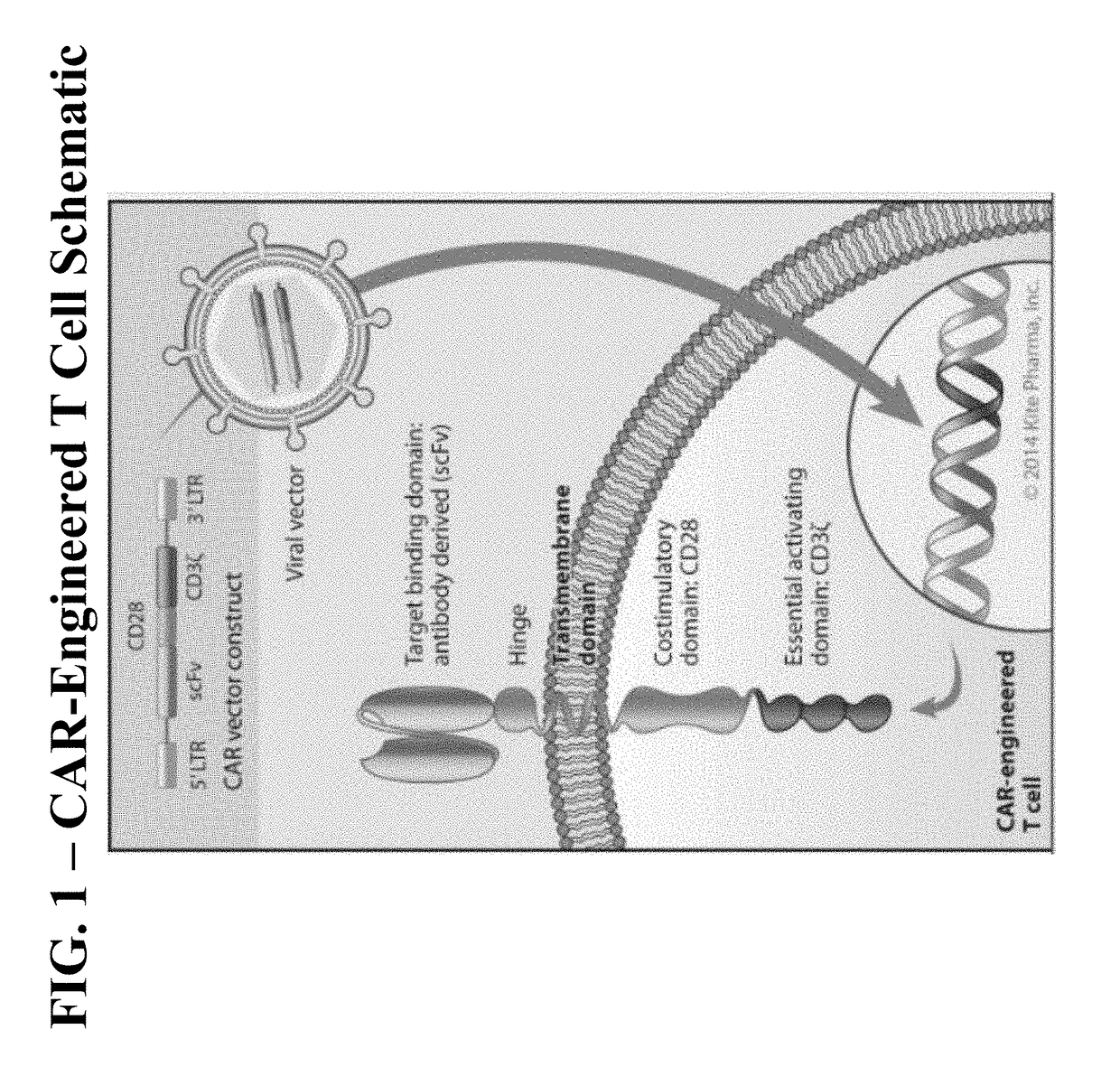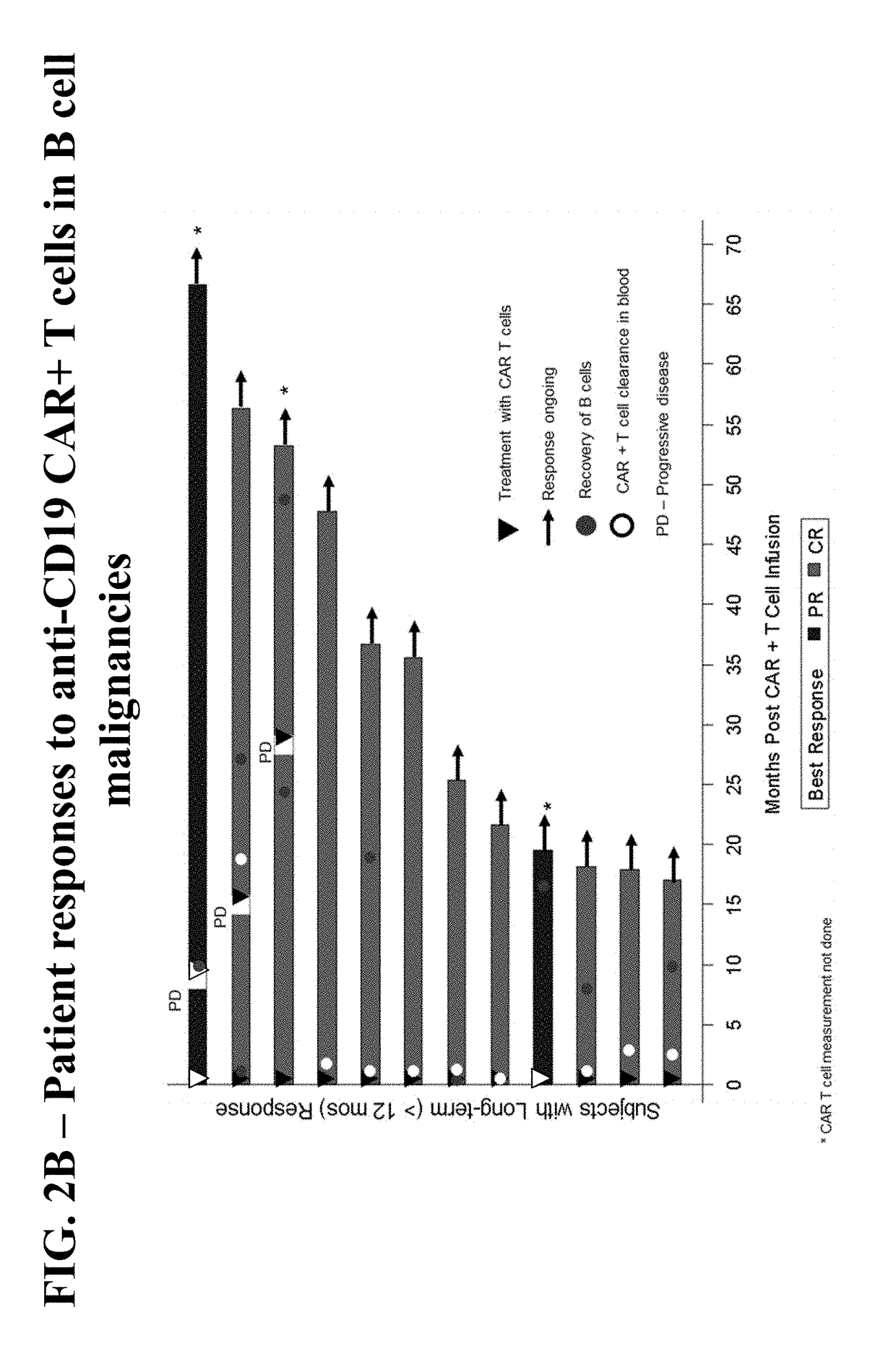Methods of conditioning patients for t cell therapy
a t cell therapy and patient technology, applied in the field of preconditioning patients, can solve the problems of difficult to predict whether a given t cell therapy will be effective in each patient, painful and sometimes deadly adverse events, and the effect of enhancing the effector function of administered t cells
- Summary
- Abstract
- Description
- Claims
- Application Information
AI Technical Summary
Benefits of technology
Problems solved by technology
Method used
Image
Examples
example 1
[0212]A phase ½, single arm, open label, trial was designed to determine the safety and feasibility of anti-CD19 CAR+ T cells administered to subjects with B cell malignancies.
[0213]Subjects who signed informed consent and met study eligibility were enrolled into the study and underwent leukapheresis to obtain PBMCs for the production of anti-CD19 CAR+ T cells. Subjects were treated with conditioning chemotherapy prior to hospitalization in preparation for a single infusion of anti-CD19 CAR+ T cells on Day 0. Some subjects were then treated with interleukin-2 (Group 1 only), 3 hours after the anti-CD19 CAR+ T cell infusion. Retreatment of a second dose of anti-CD19 CAR+ T cells was allowed if there was a response of partial response (PR) or complete response (CR) after the first infusion and then subsequent disease progression.
[0214]Three groups of subjects were enrolled. Group 1 includes 8 subjects, including 1 subject who was retreated, dosed with anti-CD19 CAR+ T cells ranging fr...
example 2
[0238]Select patients were administered a conditioning chemotherapy comprising cyclophosphamide 300 mg / m2 / day and Fludarabine 30 mg / m2 / day. The conditioning chemotherapy was administered for three days from day −5 to day −3. On day 0, a first subset of the patients (patients 22-28) (Table 6) received 10 day-manufacturing, fresh anti-CD19 CAR+ T cells, and a second subset of the patients (patients 29-32) received 6 day-manufacturing, cryopreserved anti-CD19 CAR+ T cells.
TABLE 6Condition and Outcome Data for Patients 22-28.PatientConditionOutcome22DLBCLPR23FLPR24DLBCLPR25DLBCLPR26DLBCLPD27DLBCLCR28DLBCLPDDLBCL = Diffuse Large B Cell Lymphoma;FL = Follicular Lymphoma;PR = Partial Response;CR = Complete Response;PD = Progressive Disease
[0239]Patient sera was tested by luminex using Millipore HCD8MAG15K17PMX kit (T1, T2, immune modulating cytokines, chemokines, immune effectors). The levels of interleukin 15 (IL-15), monocyte chemotactic protein 1 (MCP-1), gamma-induced protein 10 (IP-10...
example 3
[0243]To improve the depth and duration of lymphocyte depletion observed in group 3 of Example 1, the conditioning chemotherapy dose in cohort A1 will be increased to cyclophosphamide at 500 mg / m2 and fludarabine at 30 mg / m2 both given for 3 concurrent days with the target dose of 2×106 anti-CD19 CAR+ T cells / kg. The cyclophosphamide dose used in this regimen (Cohort A1) is approximately 38% lower than that used in the Group 2 cyclophosphamide 30 mg / kg conditioning regimen from Example 1 (incidence of dose limiting toxicity (DLT) 29%), with the same lower dose of fludarabine dose as Group 3 of Example 1.
[0244]Evaluation of higher conditioning chemotherapy doses and / or varying anti-CD19 CAR+ T cell doses would proceed based on the incidence of DLT and evaluation of benefit-risk. The CAR vector construct is identical to the construct described in Example 1. This example describes a clinical trial designed to test the safety and efficacy of anti-CD19 CAR+ T cells generated by a rapid, ...
PUM
| Property | Measurement | Unit |
|---|---|---|
| median time | aaaaa | aaaaa |
| time | aaaaa | aaaaa |
| time | aaaaa | aaaaa |
Abstract
Description
Claims
Application Information
 Login to View More
Login to View More - R&D
- Intellectual Property
- Life Sciences
- Materials
- Tech Scout
- Unparalleled Data Quality
- Higher Quality Content
- 60% Fewer Hallucinations
Browse by: Latest US Patents, China's latest patents, Technical Efficacy Thesaurus, Application Domain, Technology Topic, Popular Technical Reports.
© 2025 PatSnap. All rights reserved.Legal|Privacy policy|Modern Slavery Act Transparency Statement|Sitemap|About US| Contact US: help@patsnap.com



